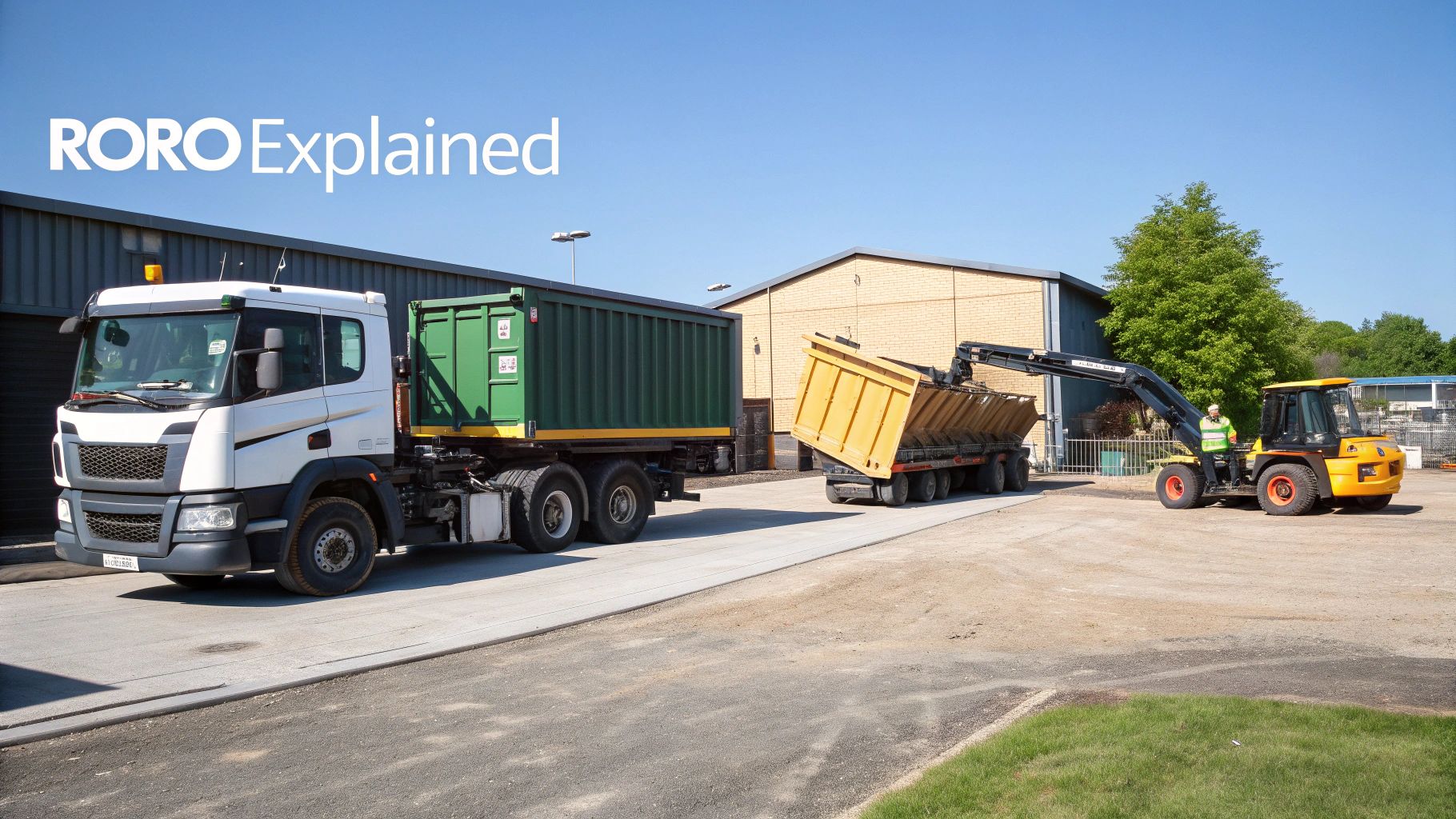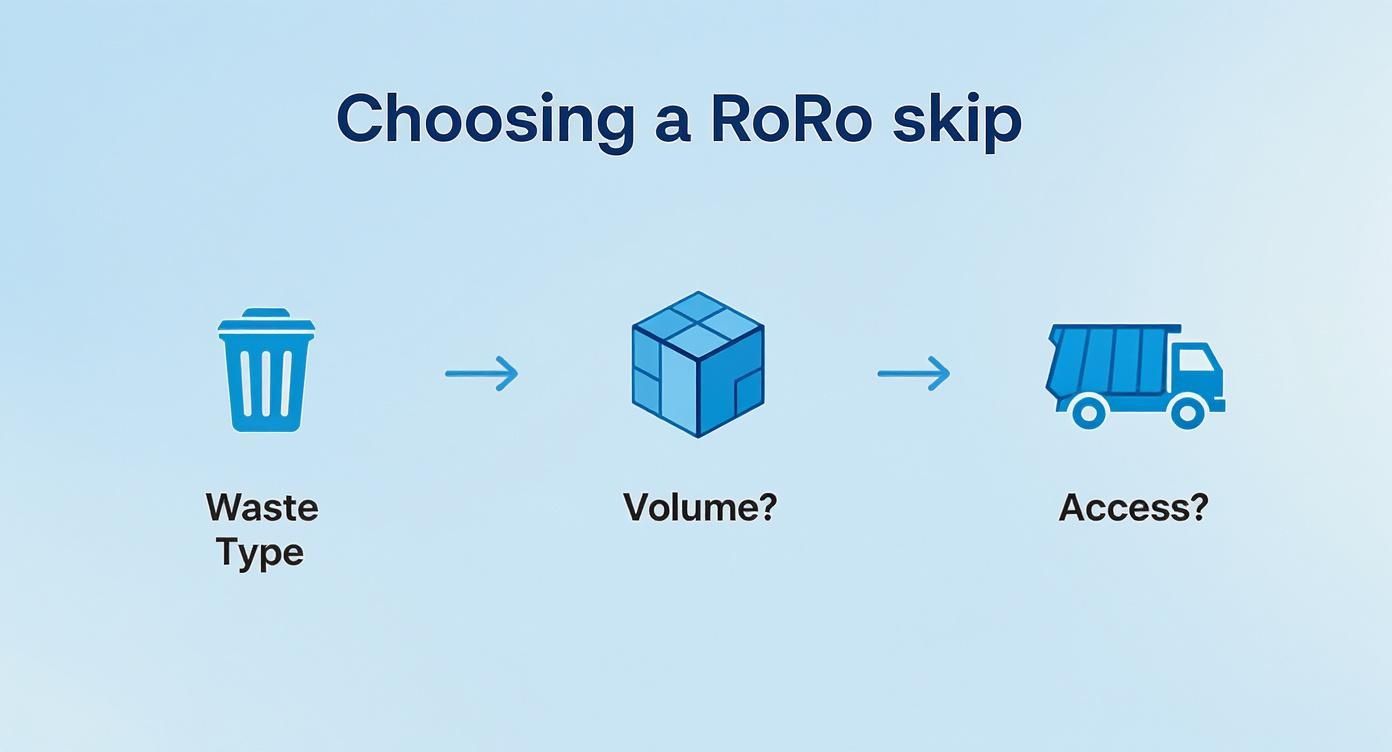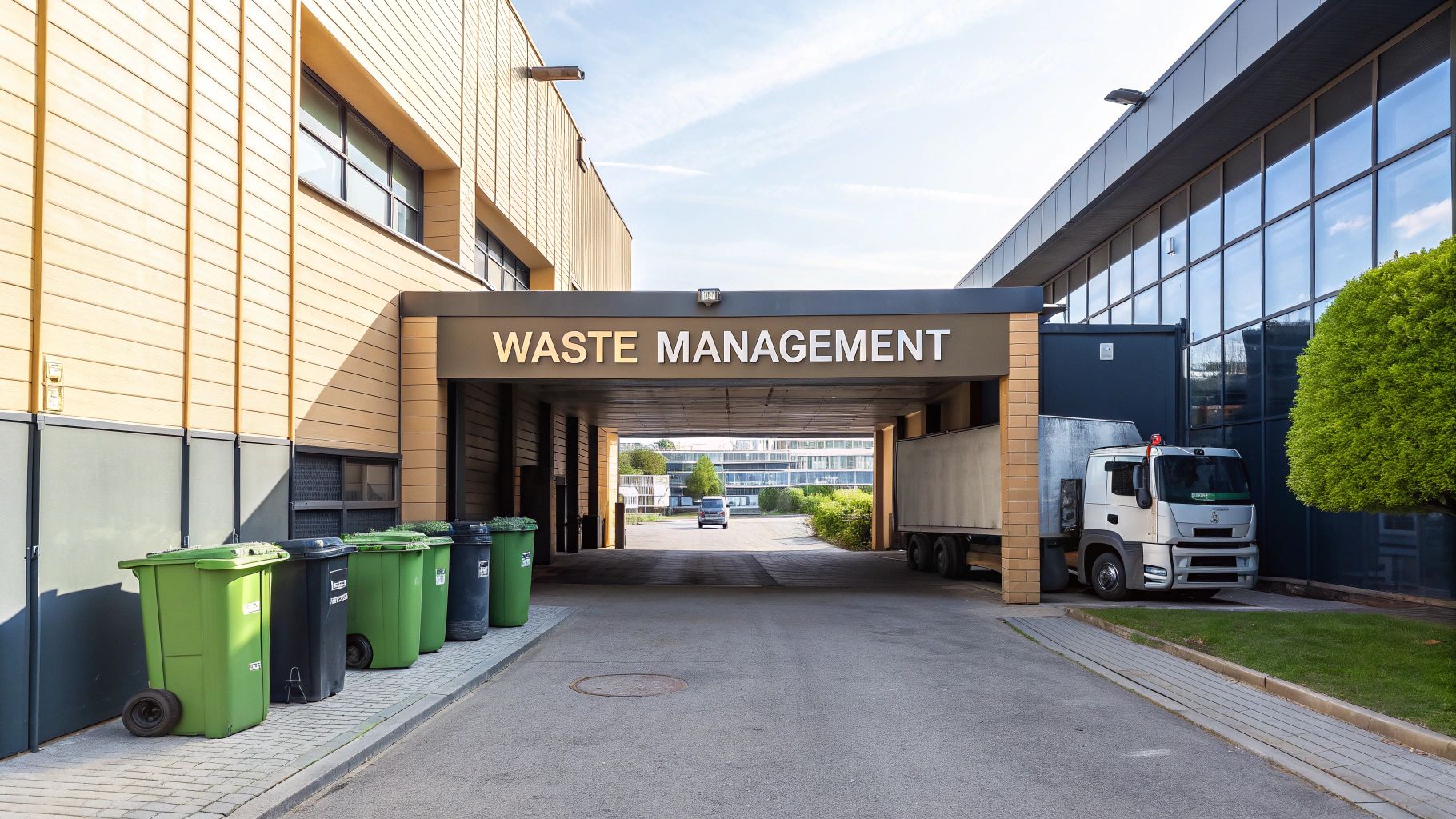A Complete Guide to Roll On Roll Off Skip Sizes
A Complete Guide to Roll On Roll Off Skip Sizes
When your project grows beyond the scope of a standard builder's skip, it's time to bring in the heavy hitters: Roll On Roll Off (RoRo) skips.
These are huge, high-capacity containers designed specifically for the massive waste streams you see in commercial, industrial, and construction settings. If a regular skip is like your car boot – great for a weekend garden clear-out – a RoRo is the articulated lorry you need for a complete site clearance.
Your Guide to Large-Scale Waste Management

RoRo containers are delivered and collected by a specialised hook-lift lorry, which, as the name suggests, literally rolls the container on and off its flatbed. This clever system is what allows them to handle the extreme weights and volumes involved.
The main advantage of a RoRo is its sheer scale. Their massive capacity makes them a genuinely cost-effective choice for big jobs. Think about it: fewer collections mean lower transport costs and, crucially, less disruption on a busy site.
Understanding RoRo Capacities and Uses
In the UK, the most common roll on roll off skip sizes range from 20 to 40 cubic yards, each built to handle bulky waste from demanding projects. The 20-yard RoRo, for example, is a real workhorse, popular for big office clear-outs or shop fit-outs. At the other end of the scale, the colossal 40-yard skip is a common sight on demolition sites, perfect for high volumes of lighter waste like timber and metal.
Choosing the right size really comes down to understanding the type of waste you'll be generating.
To help you get a clearer picture, here’s a quick rundown of the most common RoRo sizes and what they’re typically used for.
Quick Guide to RoRo Skip Sizes
| Skip Size (Cubic Yards) | Typical Dimensions (L x W x H) | Best For | Black Bag Capacity (Approx.) |
|---|---|---|---|
| 20 Yard | 6.1m x 2.4m x 1.8m | Heavy mixed construction waste, large amounts of soil, rubble, or concrete. | 220 |
| 30 Yard | 6.2m x 2.4m x 2.3m | Major construction projects, large-scale commercial clear-outs. | 330 |
| 40 Yard | 6.2m x 2.4m x 2.7m | High-volume, low-density waste like timber, metal, plastics, and packaging. | 440 |
This table should give you a solid starting point, but remember that every project is unique.
RoRo skips are all about streamlining logistics on major projects. Their ability to swallow huge quantities of waste in a single go keeps sites clear and operations moving, without the constant headache of swapping out smaller skips.
Getting your head around the different roll on roll off skip sizes is the first step toward managing your site's waste efficiently. For a full breakdown of all the options available, have a look at our complete guide to skips and RoRo hire. It’ll walk you through everything you need to know.
The 20 Yard RoRo: Your Project Workhorse

When it comes to the different roll on roll off skip sizes, the 20-yard RoRo often emerges as the unsung hero. It's easily one of the most popular and versatile options out there, hitting that sweet spot between massive capacity and manageable size on site.
To give you an idea of what it can handle, a 20-yard RoRo can hold roughly 200 to 220 standard black bin bags. This makes it the perfect fit for projects that are churning out a serious amount of waste but don't quite need the colossal footprint of a 40-yarder.
The Ideal Choice for Heavy Materials
Where the 20-yard skip truly comes into its own is with heavy, dense materials. This is the skip you call for when you’re dealing with inert waste like soil, rubble, concrete, and bricks.
Why is that so important? Well, if you fill a larger skip – like a 40-yard model – with these dense materials, you can quickly find yourself in hot water. An overweight skip can easily breach the legal weight limits for the lorry that needs to transport it, which can lead to hefty fines and a logistical nightmare. The 20-yarder gives you plenty of room while keeping the total weight safely within legal limits for road transport.
For any project involving major excavation or demolition, the 20-yard RoRo is often the only sensible choice for large-scale waste. Its design is perfectly optimised for heavy loads, avoiding the overloading risks you'd face with bigger containers.
This makes it a thoroughly dependable and safe bet for jobs where you need to get rid of heavy construction waste without any fuss.
When Is a 20 Yard RoRo the Best Fit?
This skip's well-balanced profile makes it a fantastic choice for a whole host of demanding commercial and domestic projects. It provides all the capacity you need to keep a site clear and safe, without completely taking over all your available space.
You'll want to consider a 20-yard RoRo for jobs like these:
- Major Home Renovations: It's absolutely perfect for extensions or full-scale house refurbishments that generate a mix of old plaster, timber, and masonry.
- Commercial Shop Refits: It can easily swallow up all the waste from stripping out old fixtures, flooring, and non-structural walls in retail or office spaces.
- Large Garden & Landscaping Projects: Got a huge clearance on your hands? It's ideal for disposing of large quantities of soil, turf, broken paving slabs, and other bulky garden waste.
- Construction Site Clearance: Great for efficiently managing concrete, soil, and rubble from groundworks and the initial phases of site prep.
At the end of the day, the 20-yard skip really shines when your project involves heavy materials and high volumes. It’s the reliable workhorse that ensures your waste management is both efficient and compliant from start to finish.
When to Choose the 30 or 40 Yard RoRo Skip
When your project is generating a truly staggering amount of waste, it’s time to call in the big guns. The 30-yard and 40-yard RoRo skips are the giants of the waste management world, built for maximum volume and efficiency on the biggest jobs.
But there's a crucial catch. These containers aren't for your heavy, dense materials like soil or rubble. They are engineered specifically for projects producing a huge volume of lighter, bulkier waste. Think of it like loading up a lorry: you can fill it to the brim with feathers (high volume, low weight) or with bricks (low volume, high weight). These colossal skips are strictly for the 'feathers'.
Understanding Volume vs Weight
The most important thing to get your head around with these larger skips is the balance between volume and weight. While they offer an enormous amount of space, they're still bound by the same legal road weight limits as their smaller cousins. If you tried to fill a 40-yard skip with soil, it would become dangerously overweight and impossible to move legally.
This is exactly why they are the perfect solution for waste that takes up a lot of room but doesn't weigh a great deal.
- 30-Yard RoRo: Has enough space for roughly 320 black bin bags. It's a massive step up, perfect for large-scale commercial clear-outs and major construction projects dealing with mixed, bulky waste.
- 40-Yard RoRo: As the largest standard option, this skip boasts an incredible capacity of around 440 black bin bags, making it the top choice for high-volume industrial waste.
Choosing one of these means you can clear enormous quantities of debris with fewer collections, which minimises disruption and keeps transport costs down on a busy site.
The decision to hire a 30 or 40-yard RoRo is a strategic one. It's about recognising that your waste is bulky, not dense. Getting this right prevents overloading, avoids surprise costs, and keeps your project running smoothly and safely.
Ideal Projects for the Largest RoRo Skips
So, when does it actually make sense to bring in one of these industrial-scale containers? They really shine in scenarios where getting the most waste shifted in one go is the top priority.
You should be thinking about a 30 or 40-yard skip for these kinds of projects:
- Full Warehouse or Factory Clearances: Perfect for getting rid of old packaging, racking, light machinery, and general commercial rubbish.
- Large-Scale Construction and Demolition: Ideal for managing segregated, lighter materials like timber, plastics, insulation, and scrap metal from a demolition site.
- Manufacturing and Industrial Byproducts: Efficiently handles huge volumes of production offcuts, such as wood, cardboard, and packaging waste.
- Major Retail Refits: Easily swallows up old shop fittings, display units, and large quantities of packaging from new stock.
Ultimately, opting for a 30 or 40-yard RoRo is about matching the right tool to the job. For high-volume, low-weight waste, they are simply the most cost-effective and practical solution you can find.
How to Choose the Right RoRo Skip Size
Picking the right one from the various roll on roll off skip sizes isn’t a guessing game. Get it right, and you’ll save money, sidestep delays, and keep your project running like clockwork. To nail the decision, you just need to think through four key areas.
By properly weighing up your waste type, the sheer volume of it, what your site access is like, and the overall cost, you can find the perfect skip for the job. It’s about moving past the basic descriptions and making a choice that’s genuinely right for your situation.
Evaluate Your Waste Type and Volume
First things first, what are you actually throwing away? Is it heavy, dense stuff like soil and concrete, or are you dealing with light but bulky items like timber, packaging, and old furniture? This is the single most important question you need to answer.
As we've mentioned, that 20-yard RoRo is your only option for heavy materials because of road weight limits. The bigger 30 and 40-yard skips are strictly for high-volume, low-weight debris. Mixing this up is a classic mistake that can lead to a refused collection and a surprise bill.
Next, try to work out the total amount of waste you're likely to produce. It’s always, always better to aim a little high than to fall short. Ordering a second skip because the first one filled up too quickly is far more expensive and disruptive than getting a slightly bigger one from the get-go.
Assess Your Site Access and Logistics
A RoRo skip doesn't just show up in a standard lorry; it’s delivered by a massive hook-lift vehicle that needs a serious amount of room to operate safely. Before you even think about booking one, you have to be certain your site can handle it.
You absolutely must check for:
- Enough Gate Width: Is the entrance to your site wide enough for an HGV to get through without sucking in its breath?
- A Clear, Unobstructed Route: The path to where you want the skip dropped needs to be free of tight turns, low-hanging tree branches, and inconsiderately parked cars.
- Solid Ground: The spot where the skip will sit has to be level and hard—think concrete or tarmac. This thing is heavy, and it will sink into soft ground.
Forgetting to do a proper site check is one of the most common and expensive blunders people make. If the driver turns up and can't deliver the skip, you still get charged for the journey. A few minutes with a tape measure can save you a real headache.
Consider Overall Cost-Effectiveness
Finally, step back and look at the big picture. What’s the most cost-effective solution for your specific project? A smaller skip might look cheaper on paper, but if it means you need more collections, your transport costs will quickly add up.
For large-scale clear-outs or strip-outs, hiring one 40-yard RoRo is almost always cheaper than getting two separate 20-yard skips. The trick is to find the sweet spot between the skip's capacity and the kind of waste you're producing. For a deeper dive into how different sizes stack up, our complete guide ensures all skip sizes are explained in detail. A smart choice here will save you a significant amount of time and money in the long run.
RoRo Skip Size Decision Matrix
To make things even clearer, here’s a quick-glance table to help you match your project needs to the right RoRo skip. Think of it as a cheat sheet for making the perfect choice.
| Factor | 20 Yard RoRo | 30 Yard RoRo | 40 Yard RoRo |
|---|---|---|---|
| Best For | Heavy waste: soil, rubble, concrete, bricks. | Light, bulky waste: timber, metal, general mixed waste. | Very high-volume, light waste: shop fittings, packaging. |
| Project Type | Major excavations, demolitions, large constructions. | Large commercial refits, factory clear-outs, site clearances. | Huge retail clear-outs, large-scale manufacturing waste. |
| Key Advantage | The only RoRo suitable for heavy, dense materials. | A great balance of high capacity and versatility. | Maximum possible volume for the lightest types of waste. |
| Watch Out For | Cannot be used for mixed light and heavy waste. | Strictly no soil or hardcore. Overfilling is a risk. | Absolutely no heavy materials. Requires significant site space. |
Hopefully, this matrix gives you a solid framework for deciding. By aligning your specific waste stream and project scale with the right skip, you can ensure your waste management is both efficient and economical.
Logistics You Must Consider Before Hiring
Picking out the right roll on roll off skip size is a great start, but it's the practical details of delivery and placement that will make or break your project. Getting these logistics wrong can lead to some serious headaches, unexpected costs, and frustrating delays down the line.
Before you even think about booking, the first thing you absolutely must have is a suitable spot to put it. A RoRo skip needs to be placed on level, hard-standing ground—think solid concrete or reinforced tarmac. Trying to drop one on soft ground like grass or soil is a definite no-go. The sheer weight will cause it to sink, creating a major safety hazard and making it impossible to collect later.
This decision tree can help you visualise the key steps when considering the logistics for different roll on roll off skip sizes.

As you can see, thinking through your waste type, volume, and site access is crucial to making the right choice from the get-go.
Site Access and Legal Compliance
Next up, you need to get the measuring tape out and check your site's access route. The large hook-lift HGV that delivers these skips needs a lot of room to manoeuvre. We're talking wide gates, no sharp, tight corners, and no low-hanging branches or cables. If the driver turns up and can't safely get the skip into position, you'll almost certainly still be charged for the wasted journey.
A common and costly mistake is forgetting to check the rules and regulations. From what you can't throw in to making sure it's not overfilled, these aren't just suggestions—they're legal requirements. A quick check beforehand saves you from potential fines and the hassle of having your waste collection refused.
It's vital you know what you can't put in the skip. This includes hazardous materials like asbestos, chemicals, batteries, and even plasterboard (when mixed with other waste). On top of that, all waste must be level with the top of the skip. This is a non-negotiable rule for safe transport known as a 'level load'.
If the skip needs to be placed on public land, like a road, you'll need to sort out a permit from your local council. Getting your head around the financial side of things is also key before you commit; you can learn more about the cost of skip hire near me in our detailed guide. It can also be helpful to review guides on dumpster rental costs to get a broader picture for budgeting.
Your RoRo Skip Questions Answered
When you're dealing with a project big enough for a RoRo, a few practical questions always pop up. Getting them sorted early on is the key to keeping everything running smoothly, so let's walk through the queries we hear most often.
What Is the Real Difference Between a RoRo and a Normal Skip?
Think of it as the difference between a transit van and an arctic lorry. It really comes down to scale and purpose. Your standard builder's skip is perfect for smaller trade jobs or big clear-outs at home and gets lifted into place with chains.
A RoRo, on the other hand, is an enormous container that literally rolls off a specialised hook-lift truck. They are built for huge volumes of commercial and industrial waste, making them the only sensible choice for major construction sites and large-scale clearances.
Can I Really Not Put Soil in a 40-Yard Skip?
That’s absolutely correct, and it's a rule we can't bend for safety reasons. It has nothing to do with the space inside the skip – it’s all about weight.
Soil, rubble, bricks, and concrete are incredibly dense materials. If you were to fill a 40-yard skip with them, it would be far too heavy for the lorry to legally and safely lift it and transport it on the road. For this heavy, inert waste, the 20-yard RoRo is the biggest you can go.
This weight restriction is non-negotiable. Always match your waste type to the correct roll on roll off skip sizes to avoid a failed collection and extra costs. Heavy waste goes in a 20-yarder; bulky, lighter waste can fill the bigger ones.
How Much Space Do I Actually Need for Delivery?
You'll need a lot more room than you might first imagine. The RoRo delivery lorry is a heavy goods vehicle and needs plenty of space to get in, drop the skip, and get out safely.
As a rule of thumb, make sure you have:
- A clear entrance that’s at least 3 metres (about 10 feet) wide.
- A straight approach of roughly 15 metres (around 50 feet) for the lorry to line itself up.
- No overhead obstructions like low-hanging branches or power lines along the access route.
- A solid, level surface like concrete or tarmac for the skip to sit on. Soft ground is a definite no-go.
Do I Need a Permit for a RoRo Skip?
This all depends on where you plan to put it.
If the skip will be placed entirely on private land, like a secure building site or a large private yard, then no permit is needed.
But, if any part of the skip has to sit on a public road, pavement, or verge, you will absolutely need a skip permit from your local council before it arrives.
For a hassle-free solution to your large-scale waste needs, trust The Waste Group. We provide a full range of roll on roll off skip sizes with reliable delivery across Dorset. Get your instant quote and book online today at https://www.thewastegroup.co.uk.



